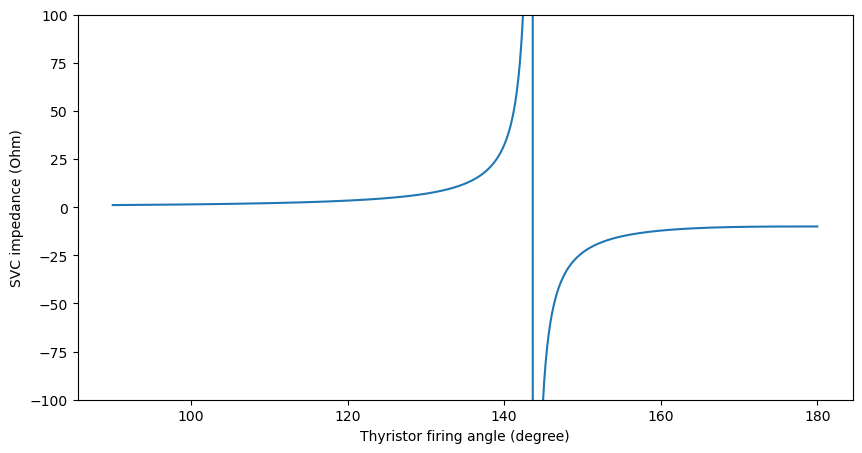Static Var Compensator (SVC)
We implement the FACTS devices based on the following source:
A. Panosyan, “Modeling of advanced power transmission system controllers”, Ph.D. dissertation, Gottfried Wilhelm Leibniz Universität Hannover, 2010.
The element SVC is a shunt-connected thyristor-based power electronic device. It regulates the voltage magnitude at the connected bus by adjusting the shunt impedance value. The shunt impedance only has the reactance component (no resistive part). The impedance can be capacitive or inductive, because the device consists of a fixed capacitor in a parallel circuit to the reactor that is regulated by a pair of antiparallel thyristors. The thyristor firing angle regulates the total impedance of the element.
The active range of the device is presented in the figure below:

It can be seen that the device has a resonance region between the inductive (positive) and the capacitive (negative) impedance characteristics. In real application, the operation of the device in the resonance region is prohibited by defining the inadmissible range for the thyristor firing angle around the resonance point. We did not implement this in our software - this should be considered for future work.
The device operates in the value range of the thyristor firing angle between 90° and 180°. Any results for the thyristor firing angle outside of this range are invalid (we have not observed a converged result with values outside of the valid range in the test cases). Even though we include the values of min_angle_degree and max_angle_degree in the create function, they are not considered during the power flow calculation. For future work, the functionality similar to “enforce_q_lims” should be implemented.
We demonstrate the use-case of this device in the pandapower tutorial: FACTS.
See also
Create Function
- pandapower.create.create_svc(net, bus, x_l_ohm, x_cvar_ohm, set_vm_pu, thyristor_firing_angle_degree, name=None, controllable=True, in_service=True, index=None, min_angle_degree=90, max_angle_degree=180, **kwargs)
Creates an SVC element - a shunt element with adjustable impedance used to control the voltage at the connected bus
Does not work if connected to “PV” bus (gen bus, ext_grid bus)
min_angle_degree, max_angle_degree are placeholders (ignored in the Newton-Raphson power flow at the moment).
- INPUT:
net (pandapowerNet) - The pandapower network in which the element is created
bus (int) - connection bus of the svc
x_l_ohm (float) - inductive reactance of the reactor component of svc
x_cvar_ohm (float) - capacitive reactance of the fixed capacitor component of svc
set_vm_pu (float) - set-point for the bus voltage magnitude at the connection bus
- thyristor_firing_angle_degree (float) - the value of thyristor firing angle of svc (is used directly if
controllable==False, otherwise is the starting point in the Newton-Raphson calculation)
- OPTIONAL:
name (list of strs, None) - element name
- controllable (bool, True) - whether the element is considered as actively controlling or
as a fixed shunt impedance
in_service (bool, True) - True for in_service or False for out of service
- index (int, None) - Force a specified ID if it is available. If None, the
index one higher than the highest already existing index is selected.
min_angle_degree (float, 90) - minimum value of the thyristor_firing_angle_degree
max_angle_degree (float, 180) - maximum value of the thyristor_firing_angle_degree
- OUTPUT:
index (int) - The unique ID of the created svc
Input Parameters
net.svc
Parameter |
Datatype |
Value Range |
Explanation |
name |
string |
name of the SVC |
|
bus* |
integer |
index of bus where the SVC is connected |
|
x_l_ohm* |
float |
\(\geq\) 0 |
impedance of the reactor component of SVC |
x_cvar_ohm* |
float |
\(\leq\) 0 |
impedance of the fixed capacitor component of SVC |
set_vm_pu* |
float |
set-point for the bus voltage magnitude at the connection bus |
|
thyristor_firing_angle_degree* |
float |
:math:90 leq 180 |
the value of thyristor firing angle of SVC |
controllable* |
boolean |
True / False |
whether the element is considered as actively controlling or as a fixed shunt impedance |
in_service* |
boolean |
True / False |
specifies if the SVC is in service. |
min_angle_degree |
float |
\(\geq\) 90 |
minimum value of the thyristor_firing_angle_degree |
max_angle_degree |
float |
\(\leq\) 180 |
maximum value of the thyristor_firing_angle_degree |
*necessary for executing a power flow calculation.
Electric Model

The shunt impedance \(X_{SVC}\) of the SVC element is calculated according to the following equation:
The term \(X_L\) stands for the reactance of the reactor (x_l_ohm) and the term \(X_{Cvar}\) stands for the total capacitance (x_cvar_ohm). The thyristor firing angle \(\alpha\) is the state variable that on the one hand defines the impedance of the element, and at the same time is the result of the Newton-Raphson calculation.
The reactive power consumption of the SVC element is calculated with:
Where V is the complex voltage observed at the connection bus of the SVC element. The reference values for the per unit system as defined in Unit Systems and Conventions.
Result Parameters
net.res_svc
Parameter |
Datatype |
Explanation |
thyristor_firing_angle_degree* |
float |
the resulting value of thyristor firing angle of svc [degree] |
x_ohm |
float |
resulting value of the shunt impedance of svc [Ohm] |
q_mvar |
float |
shunt reactive power consumption of svc [MVAr] |
vm_pu |
float |
voltage magnitude at svc bus [pu] |
va_degree |
float |
voltage angle at svc bus [degree] |